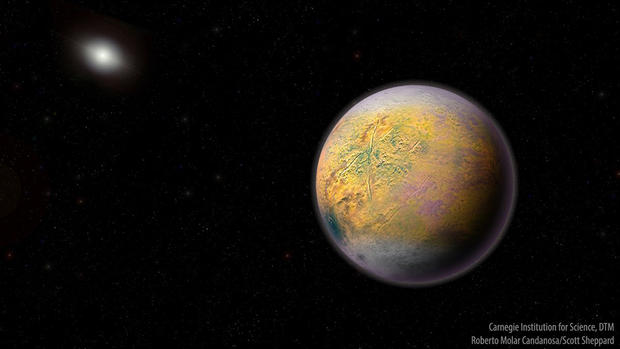Massachusetts-Sized Object Beyond Pluto Hints At Hidden Planet X
(CNET) -- Astronomers have found a small object far beyond Pluto that orbits the sun in a lonely, oblong loop, a discovery that supports the notion of a larger, more distant planet -- often referred to as Planet X -- wandering the edge of our solar system.
The object, 2015 TG387, is likely a dwarf planet with a diameter of about 300 kilometers (186 miles), making it about as wide as Massachusetts is long. It was found roughly 80 astronomical units (AU) from the sun. An AU is equal to the distance between the sun and Earth, or roughly 150 million kilometers (93 million miles). Pluto is about 34 AU from the sun, so 2015 TG387 is two and a half times farther from the sun than the former ninth planet.
The new find, which has been nicknamed "The Goblin," was introduced Tuesday by the International Astronomical Union's Minor Planet Center. A full report has been submitted to The Astronomical Journal.
Scott Sheppard, an astronomer at the Carnegie Institution for Science who is one of the co-discoverers, and his colleagues are among those who have observed similarities in the orbits of a number of very distant solar system objects, like 2015 TG387. That has led them to propose the existence of an undiscovered planet several times larger than Earth orbiting far beyond Pluto at hundreds of AU.
"These distant objects are like breadcrumbs leading us to Planet X," Sheppard said in a release. "The more of them we can find, the better we can understand the outer solar system and the possible planet that we think is shaping their orbits."
Discovering Planet X would "redefine our knowledge of the solar system's evolution," he added.
2015 TG387 makes very elongated, 40,000-year orbits around our star that take it as far as 2,300 AU at its furthest point from the sun. It's actually pretty lucky that astronomers were able to spot it as they say it would be too faint to see for 99 percent of its orbit.
"What makes this result really interesting is that Planet X seems to affect 2015 TG387 the same way as all the other extremely distant solar system objects," co-discoverer Chad Trujillo of Northern Arizona University said. "These simulations do not prove that there's another massive planet in our solar system, but they are further evidence that something big could be out there."




